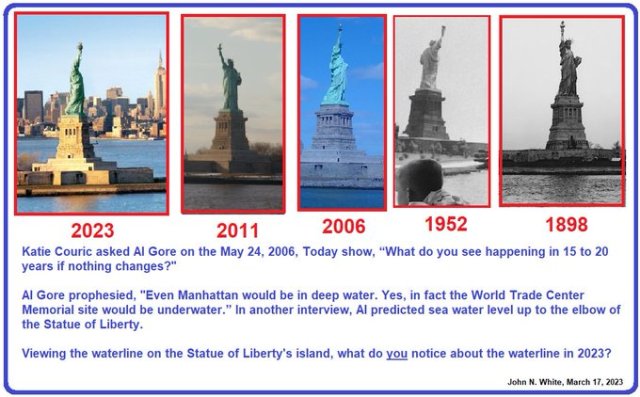Introduction

Human nature craves simple solutions to problems of all types. The modern-day climate alarmists are ordinary humans whose singular myopic focus is anthropogenic causality, nothing more, nothing less than simplistic thinking.
Climate alarmism is not a new craze. The present-day movement began with the publishing of the book Silent Spring by Rachel Carson. Carson’s survey of the research on pesticides opens in a most unscientific fashion with a tale about an American town that has suffered a series of plagues. In 1971, global cooling was the climate threat du jour.
In the late 1970s, alarmism over anthropogenic causes of ozone depletion over the South Pole arose. Climate alarmists attributed ozone (O3) depletion to our use of refrigerants and hairspray products in the Northern Hemisphere. Such was impossible due to two scientific facts: (1) emissions of halogens by Mount Erebus, an active volcano in Antarctica, and the natural isolation of the Southern Hemisphere from the Northern Hemisphere due to the double air-curtain effect of the Intertropical Convergence Zone (ITCZ), aka The Doldrums, aka the Chemical Equator (2008).
I reflect on a question asked of God by the prophet Jeremiah.
“Righteous are You, O Lord, that I plead with You. Indeed, let me talk with You about matters of justice. Why does the way of the wicked prosper? Why are all those happy who deal very treacherously?” Jeremiah 12:1
God answers: “If you have run with the footmen, and they have wearied you, then how can you contend with horses? And if in the land of peace in which you trusted, they wearied you, then how will you do in the thicket of the Jordan?” Jeremiah 12:5
Old Testament, the book of Jeremiah, Modern English Version, from BibleGateway
Scientia Potentia Est
Sir Francis Bacon, 1597
Knowledge Is Power
Founding Father Thomas Jefferson, 1817
Admiral Chester Nimitz wisely stated, “The bulwarks of our liberty are men and women who read and think.“
I invite you to read the following excerpts from scientific and journalistic resources. Expect your thinking to be stimulated, giving you the wherewithal to contend with simple-minded alarmists. I challenge you to be a bulwark of our liberty.
Gleissberg cycle of solar activity
The Sun directly or indirectly affects terrestrial phenomena, and solar activity has a profound influence on geophysical processes (e.g., global change, atmospheric circulation, climatic change). Learn more from ScienceDirect: Gleissberg cycle of solar activity over the last 7000 years.
Among other longer-than-22-year periods in Fourier spectra of various solar–terrestrial records, the 88-year cycle is unique, because it can be directly linked to the cyclic activity of sunspot formation. Variations of amplitude as well as of period of the Schwabe 11-year cycle of sunspot activity have actually been known for a long time and a ca. 80-year cycle was detected in those variations. Learn more from AGU Journal of Geophysical Research, Space Physics | Persistence of the Gleissberg 88-year solar cycle over the last ∼12,000 years: Evidence from cosmogenic isotopes
Milankovitch (Orbital) Cycles
Cycles also play key roles in Earth’s short-term weather and long-term climate. A century ago, Serbian scientist Milutin Milankovitch hypothesized the long-term, collective effects of changes in Earth’s position relative to the Sun are a strong driver of Earth’s long-term climate, and are responsible for triggering the beginning and end of glaciation periods (Ice Ages).
Specifically, he examined how variations in three types of Earth orbital movements affect how much solar radiation (known as insolation) reaches the top of Earth’s atmosphere as well as where the insolation reaches. These cyclical orbital movements, which became known as the Milankovitch cycles, cause variations of up to 25 percent in the amount of incoming insolation at Earth’s mid-latitudes (the areas of our planet located between about 30 and 60 degrees north and south of the equator). Learn more from NASA’s Jet Propulsion Laboratory, Milankovitch (Orbital) Cycles and Their Role in Earth’s Climate: Global Climate Change
Volcanoes
Volcanoes can impact climate change. During major explosive eruptions, huge amounts of volcanic gas, aerosol droplets, and ash are injected into the stratosphere. Injected ash falls rapidly from the stratosphere — most of it is removed within several days to weeks — and has little impact on climate change. But volcanic gases like sulfur dioxide can cause global cooling, while volcanic carbon dioxide, a greenhouse gas, has the potential to promote global warming.
Sulfate aerosols can cool the climate and deplete Earth’s ozone layer
The most significant climate impacts from volcanic injections into the stratosphere come from the conversion of sulfur dioxide to sulfuric acid, which condenses rapidly in the stratosphere to form fine sulfate aerosols. The aerosols increase the reflection of radiation from the Sun back into space, cooling the Earth’s lower atmosphere or troposphere. Learn more from the U.S. Geological Survey (USGS) Volcano Hazards Program, Volcanoes Can Affect Climate
Earth’s Magnetic-Field
Rock samples show that variations in Earth’s magnetic field over tens to hundreds of thousands of years are roughly synchronized with the ice ages. In Physical Review Letters, researchers present a simulation that strengthens the case that the field was influenced by climate changes. The simulation shows that the magnetic field is stronger when Earth rotates faster, which could have occurred when the polar ice caps expanded. The researchers’ model assumes an unrealistically large variation in Earth’s rotation rate in order to show the effect clearly, but the findings could still help geophysicists better understand the value of Earth’s magnetic field record as an indicator of climate history.

Shorter days, stronger field. Like a spinning ice skater pulling in her arms, the Earth rotates faster when more of its water mass accumulates in the form of ice at the poles during ice ages (polar ice from 2009 shown here). Researchers have now simulated the effects of this changing rotation rate on the strength of Earth’s magnetic field. Learn more from Physics: Simulations Strengthen Earth’s Magnetic-Field/Climate Connection
Atmospheric Aerosols
Take a deep breath. Even if the air looks clear, it’s nearly certain that you’ll inhale tens of millions of solid particles and liquid droplets. These ubiquitous specks of matter are known as aerosols, and they can be found in the air over oceans, deserts, mountains, forests, ice, and every ecosystem in between. They drift in Earth’s atmosphere from the stratosphere to the surface and range in size from a few nanometers—less than the width of the smallest viruses—to several several tens of micrometers—about the diameter of human hair. Despite their small size, they have major impacts on our climate and our health. Learn more from NASA Earth Observatory, Aerosols: Tiny Particles, Big Impact
Aerosols interact both directly and indirectly with the Earth’s radiation budget and climate. As a direct effect, the aerosols scatter sunlight directly back into space. As an indirect effect, aerosols in the lower atmosphere can modify the size of cloud particles, changing how the clouds reflect and absorb sunlight, thereby affecting the Earth’s energy budget. Learn more from NASA, Atmospheric Aerosols: What Are They, and Why Are They So Important?
The Atlantic Gulf Stream
The Gulf Stream is a strong ocean current that brings warm water from the Gulf of Mexico into the Atlantic Ocean. It extends all the way up the eastern coast of the United States and Canada.
This strong current of warm water influences the climate of the east coast of Florida, keeping temperatures there warmer in the winter and cooler in the summer than the other southeastern states. Since the Gulf Stream also extends toward Europe, it warms western European countries as well.
In fact, England is about the same distance from the equator as cold regions of Canada, yet England enjoys a much warmer climate. If it weren’t for the warm water of the Gulf Stream, England would have a much colder climate. Learn more from the National Oceanic and Atmospheric Administration (NOAA), What Is the Gulf Stream?

Gravitational Influences of the Moon and the Sun on Climate
Tides in the ocean are caused by the gravitational force between Earth and the moon. There are also atmospheric tides.
Lunar gravity affects the density of the thermosphere, which is the largest layer of the atmosphere. This is also where many satellites and the International Space Station orbit Earth. This lunar-induced drag is small, but it has to be included in the models used to predict the satellites’ orbits. The moon also affects the pressure at Earth’s surface.
When the moon is overhead, its gravitation pull causes Earth’s atmosphere to bulge toward it. Since the pressure at the surface is determined by the amount of air above you, the pressure, or weight, of the atmosphere on that side of the planet increases. Learn more from The Weather Guys, Does the moon affect the weather?
Together, the gravitational pull of the moon and the sun affect the Earth’s tides on a monthly basis. When the sun, moon, and Earth are in alignment (at the time of the new or full moon), the solar tide has an additive effect on the lunar tide, creating extra-high high tides, and very low, low tides — both commonly called spring tides. One week later, when the sun and moon are at right angles to each other, the solar tide partially cancels out the lunar tide and produces moderate tides known as neap tides. During each lunar month, two sets of spring and two sets of neap tides occur.
Just as the angles of the sun, moon and Earth affect tidal heights over the course of a lunar month, so do their distances to one another. Because the moon follows an elliptical path around the Earth, the distance between them varies by about 31,000 miles over the course of a month. Once a month, when the moon is closest to the Earth (at perigee), tide-generating forces are higher than usual, producing above-average ranges in the tides. About two weeks later, when the moon is farthest from the Earth (at apogee), the lunar tide-raising force is smaller, and the tidal ranges are less than average. A similar situation occurs between the Earth and the sun. When the Earth is closest to the sun (perihelion), which occurs about January 2 of each calendar year, the tidal ranges are enhanced. When the Earth is furthest from the sun (aphelion), around July 2, the tidal ranges are reduced (Sumich, J.L., 1996; Thurman, H.V., 1994). Learn more from NOAA National Ocean Service, Tides and Water Levels: Tidal Variations – The Influence of Position and Distance
Solar Wind
The solar wind is a continual stream of protons and electrons from the sun’s outermost atmosphere — the corona.
These charged particles breeze through the solar system at speeds ranging from around 250 miles (400 kilometers) per second to 500 miles (800 km) per second, in a plasma state, according to the National Oceanic and Administration Space Weather Prediction Center (SWPC).
When the solar wind reaches Earth it sends a flurry of charged particles into the magnetosphere and along Earth’s magnetic field lines, towards the poles. The interaction of these particles with Earth’s atmosphere can produce glowing aurora displays above polar regions.

The existence of the solar wind was first proposed by pioneering astrophysicist Eugene Parker whose name graces NASA’s Parker Solar Probe mission … Then in 1962, NASA’s Mariner 2 spacecraft detected the presence of solar wind particles during its voyage to Venus … In addition to the constant streams of solar wind, the sun sometimes expulses massive quantities of those charged particles in one go. These events, known as coronal mass ejections (CMEs), can trigger geomagnetic storms in the environment around Earth, which are associated with the beautiful aurora displays, but can also wreak havoc with power grids, telecommunication networks and satellites orbiting the planet … Abnormally fast solar winds can be generated during coronal mass ejection (CME) events. During CMEs, wind speeds can jump up to more than 600 miles (1000 km) per second, according to SpaceWeatherLive.com … During a geomagnetic storm, Earth’s atmosphere absorbs energy from the storms, heats up and expands upwards, leading to a significantly denser thermosphere that extends from about 50 miles (80 km) to approximately 600 miles (1,000 km) above the Earth’s surface. Learn more from Space.com, Solar wind: What is it and how does it affect Earth?
Final Word on False Prophets
For such are false apostles and deceitful workers, disguising themselves as apostles of Christ. And no wonder! For even Satan disguises himself as an angel of light. Therefore it is no great thing if his ministers also disguise themselves as ministers of righteousness, whose end will be according to their works.
The Holy Bible, Modern English Version, 2 Corinthians 11:13-15
John White
Rockwall, Texas


